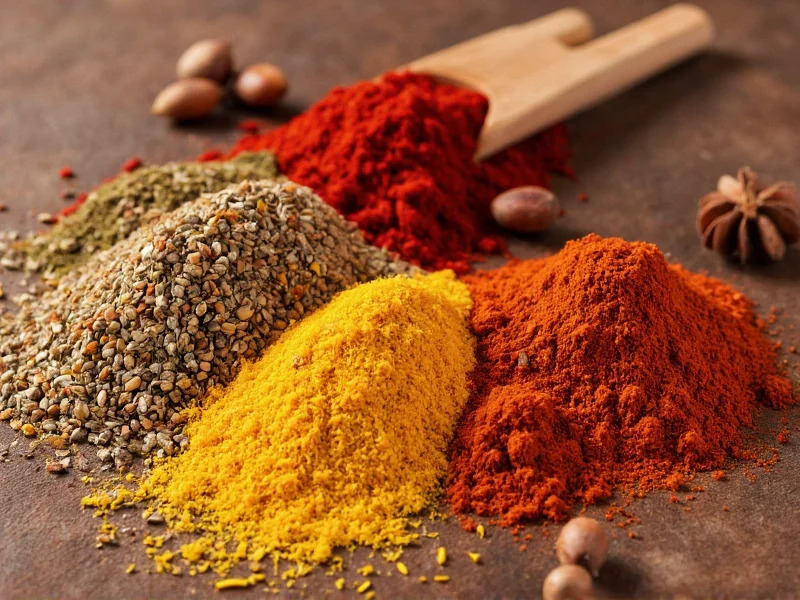Understanding which spices complement different ingredients transforms ordinary meals into extraordinary culinary experiences. This comprehensive guide explores practical spice applications based on scientific flavor pairing principles and culinary tradition.
Understanding Spice Categories
Spices fall into distinct flavor profiles that determine their best applications. Recognizing these categories helps home cooks make informed choices when developing recipes or adapting existing ones.
Essential Spices for Protein Pairing
Proteins provide the perfect canvas for spice application. The right spice combinations enhance natural flavors without overwhelming the dish.
| Protein Type | Recommended Spices | Flavor Enhancement Tips |
|---|---|---|
| Chicken | Paprika, thyme, rosemary, garlic powder | Add dried herbs early in cooking; fresh herbs in final 10 minutes |
| Beef | Black pepper, cumin, coriander, smoked paprika | Bloom whole spices in oil before adding meat for deeper flavor |
| Fish | Dill, lemon pepper, fennel, tarragon | Use delicate spices; apply just before cooking to preserve volatile oils |
| Vegetarian proteins | Turmeric, cumin, garam masala, smoked paprika | Toast spices before incorporating to enhance earthy notes |
Vegetable and Grain Spice Pairings
Vegetables respond differently to spices based on their natural sugar content and texture. Root vegetables like carrots and potatoes benefit from warm spices like cinnamon and nutmeg, while cruciferous vegetables pair well with mustard seed and cumin.
When cooking grains, consider the spice application method. For rice dishes, toast whole spices like cardamom pods and cinnamon sticks in the cooking oil before adding the rice. For quinoa or couscous, mix ground spices directly with the dry grain before cooking.
Building Balanced Spice Blends
Creating your own spice blends ensures freshness and allows customization to your taste preferences. A well-constructed blend typically includes:
- Base spices (40-50% of blend) - paprika, cumin, or coriander
- Aromatic spices (25-30%) - garlic powder, onion powder, or celery seed
- Accent spices (15-20%) - cayenne, mustard powder, or fenugreek
- Finishing spices (5-10%) - dried herbs or citrus zest
When developing spice blends for specific cuisines, research traditional combinations but don't be afraid to experiment. Middle Eastern za'atar typically contains sumac, thyme, and sesame seeds, while Indian garam masala varies by region but commonly includes cinnamon, cardamom, and cloves.
Common Spice Application Mistakes
Many home cooks make these frequent errors when working with spices:
- Adding ground spices too early in cooking, causing flavor degradation
- Using expired spices that have lost their volatile oils
- Not toasting whole spices before grinding
- Overpowering delicate ingredients with strong spices
- Mixing spices with cold liquids instead of hot fats
For optimal results, add ground spices during the last 5-10 minutes of cooking. Whole spices benefit from being toasted in a dry pan for 1-2 minutes before use. Always bloom spices in hot oil rather than adding them directly to water-based liquids.
Proper Spice Storage Techniques
Spice longevity depends on proper storage. Exposure to light, heat, and moisture degrades flavor compounds rapidly. Follow these guidelines:
- Store in airtight containers away from stove and sink
- Keep in a cool, dark cabinet (not above the stove)
- Label containers with purchase date
- Replace ground spices every 6-12 months
- Replace whole spices every 1-2 years
For extended freshness, consider storing valuable spices like saffron or vanilla in the freezer. Test spice freshness by rubbing a small amount between your fingers and smelling - vibrant spices should release a strong, characteristic aroma.
Frequently Asked Questions
What are the most versatile spices for beginner cooks?
Black pepper, cumin, paprika, garlic powder, and cinnamon form the foundation of most global cuisines. These five spices work across multiple protein types and cooking methods, providing maximum flexibility for new cooks developing their spice repertoire.
How can I tell if my spices have gone bad?
Fresh spices should have a strong, distinctive aroma when rubbed between your fingers. If you can't detect a clear scent or the color has faded significantly, the spices have likely lost their volatile oils and should be replaced. Ground spices typically last 6-12 months, while whole spices remain potent for 1-2 years.
Which spices work best with vegetables?
Root vegetables pair well with warm spices like cinnamon and nutmeg. Cruciferous vegetables like broccoli and cauliflower benefit from mustard seed and cumin. For tomatoes and peppers, try oregano and basil. When roasting vegetables, toss them with olive oil and spices before cooking to allow the flavors to penetrate.
Should I use whole or ground spices?
Whole spices maintain their flavor longer and offer more complex taste profiles when toasted before use. Ground spices provide convenience and distribute flavor more evenly. For best results, toast whole spices in a dry pan for 1-2 minutes until fragrant, then grind them yourself just before cooking.
How do I create balanced spice blends without overpowering my dish?
Start with small quantities - 1/4 to 1/2 teaspoon per serving - and adjust after the dish has cooked. Remember that spice flavors intensify as they cook. Balance strong spices with complementary flavors: pair heat from cayenne with sweetness from paprika, or offset earthy cumin with bright citrus notes. Always taste and adjust seasoning at the end of cooking.











 浙公网安备
33010002000092号
浙公网安备
33010002000092号 浙B2-20120091-4
浙B2-20120091-4